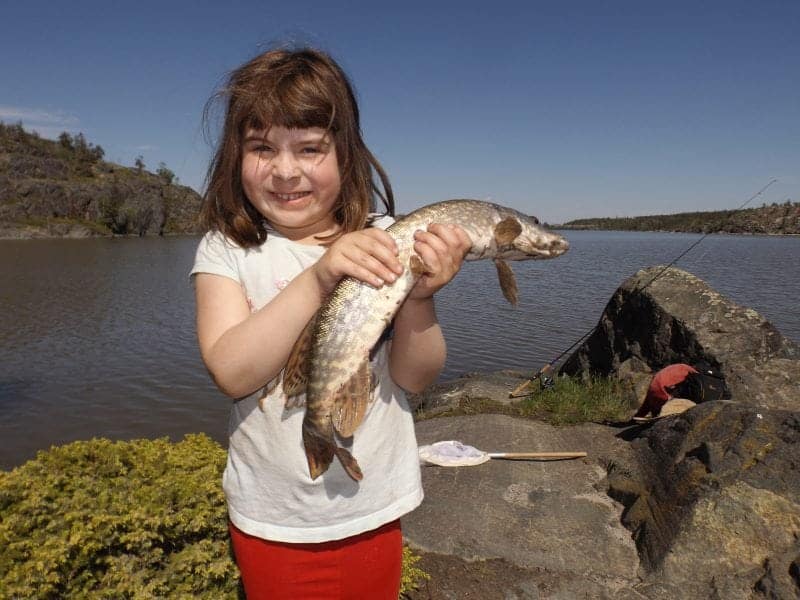Arsenic, arsenic, arsenic – when it comes to lakes around Yellowknife that seems to be all we hear these days.

Mike W. Bryant/NNSL photo
The drum beat of alarm probably comes too late for this lifer ‘Knifer. I was swimming the water and eating the fish decades before Giant Mine belched its last arsenic cloud.
Nonetheless, in the spirit of these anxious times I decided to explore local lakes to see how they’re faring years after the mines have closed.
So for my first arsenic quest of the year let me please introduce the aptly named Jackfish Lake. Sampling puts arsenic levels in Jackfish at 91.7 parts per billion – just short of the nasty red dot status affixed to Kam or Frame Lake on the GNWT’s arsenic map but bad enough to rate an orange dot. Either way, eating fish from here is still a no-no.
It was Father’s Day so I enlisted my five-year-old daughter Alexie to help. We didn’t go splashing around in the water but I made sure she wore rubber boots just in case.
Although Jackfish is almost cheek to jowl to the downtown core it remains largely inaccessible. Ringed by steep, lichen-encrusted hills, the only safe place to find shore was to go through Lakeview Cemetery and intersect the Jackfish Lake walking trail.
Out of view from the power plant and city dump, it’s one beautiful spot. Life is everywhere.
A cheeky red squirrel serenaded us from a tall white pine as we walked down to the lake. In a sunlit clearing, Jutta Arctic butterflies and four-spotted skimmer dragonflies danced above the trail.
The first thing you notice when you reach the shore of Jackfish Lake is the colour of the water. You can see it from the highway but it is nowhere near as stark as when standing at the water’s edge. Like pea soup but fouler.
It’s clear the nutrient load of this water is very high and I doubt that's a good thing. Anyone who has ever seen an aquarium where the fish are overfed will know what I’m talking about.
Jackfish Lake is very small but it once had a reputation for producing large pike. Many photos have been turned into the newspaper with the lake in the background showing pike well over 40 inches long.
Stock Lake massacre
I saw this firsthand when I was nine years old while participating in a government-sanctioned cull of all the native fish from the lake so they could be replaced with stocked rainbow trout, hence the lake's other name, Stock Lake.
The stocking never took place, however. Gill nets were stretched across the lake one weekend and from them we pulled many giant pike, as well as huge jumbo lake whitefish. But despite our best efforts to massacre every living fish in the lake its original inhabitants survived.
My question, as I stood on the shore with my daughter peering into the rusty, red water, was whether this is still the case today.
The lake has been hammered by blue-green algae blooms and from what I know about them, they are pretty hard on everything else living in the lake. When the tiny organisms die the bacteria that consumes them use up oxygen in the water.
It did not look good, and we were in a shallow part of the lake.
By and by though, the familiar flash of a rushing pike appeared by the water's edge as the fish missed my lure. Soon a two-pound pike was at hand, and not long after that – the most thrilling part of the afternoon – my daughter was fighting a much larger fish on the Shakespeare spin-caster I purchased for her a few hours earlier.
“Something's happening!” Alexie screamed as her rod doubled over toward the water.
A very proud moment. It was the first time my daughter had cast a lure and hooked and landed a fish all by herself. Like my first fish, it was the ever willing northern pike.
“I LOVE fishing!” Alexie exclaimed as she tried to lift the 30-inch fish up for the camera. Unfortunately, the pike jumped out of her hands and back into the water, so the picture you're looking at is of Alexie with my much smaller fish.
Anyway, I think Alexie has got the bug. She is already pressing for our next fishing trip.
I really hope there are still fish in Jackfish Lake should she takes her children fishing some day.
Fish have persisted in this water since glaciers receded 10,000 years ago. They endured the gold rush, the smelting, the arsenic, the warm-water discharge from the power plant and runoff from the dump. And so far, drought, climate change and algae blooms.
These fish are tenacious, and for that they deserve our respect ... and protection. But who knows how many more hits they can take?